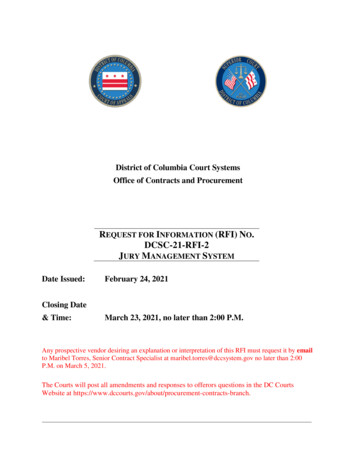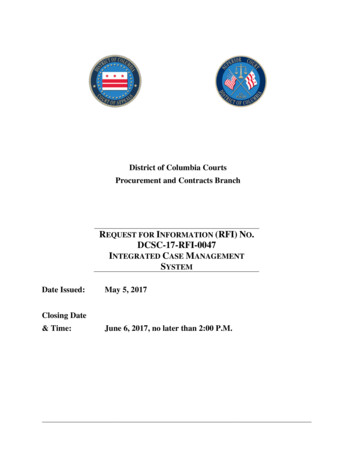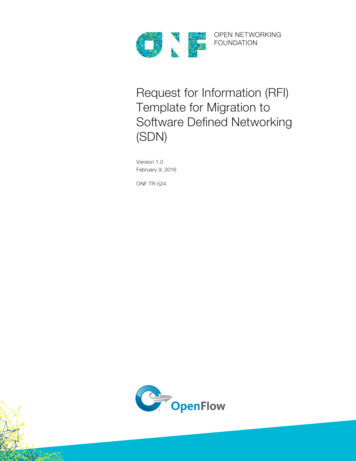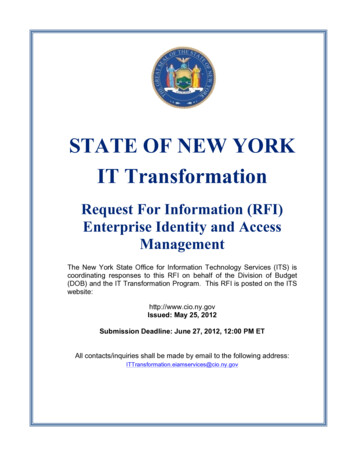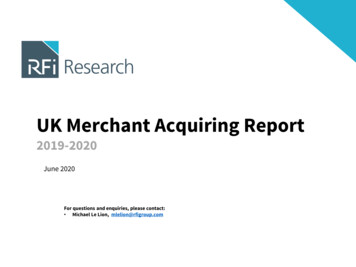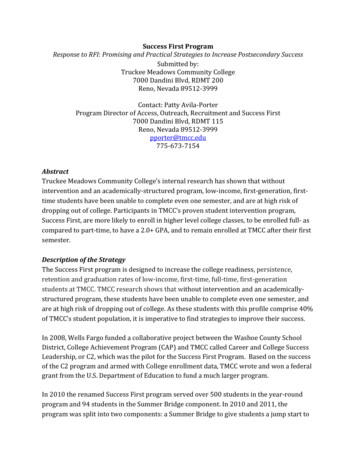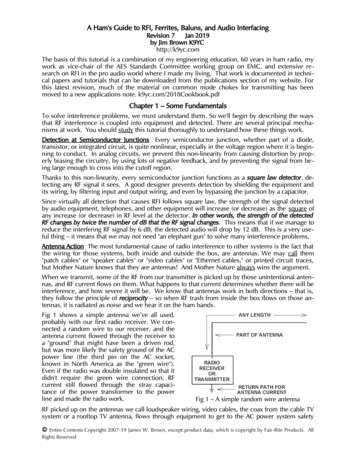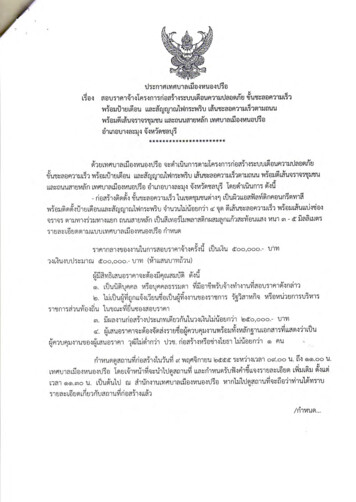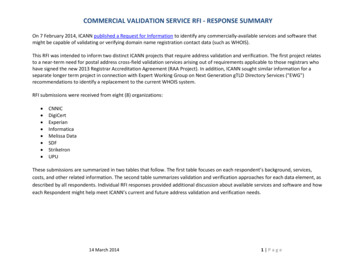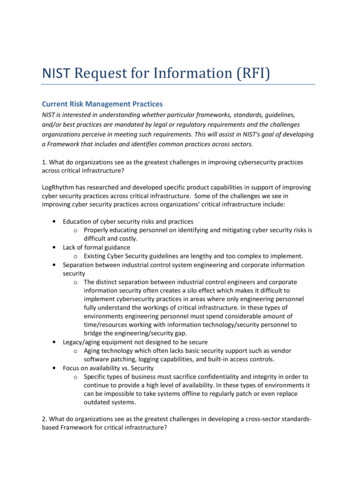
Transcription
NIST Request for Information (RFI)Current Risk Management PracticesNIST is interested in understanding whether particular frameworks, standards, guidelines,and/or best practices are mandated by legal or regulatory requirements and the challengesorganizations perceive in meeting such requirements. This will assist in NIST's goal of developinga Framework that includes and identifies common practices across sectors.1. What do organizations see as the greatest challenges in improving cybersecurity practicesacross critical infrastructure?LogRhythm has researched and developed specific product capabilities in support of improvingcyber security practices across critical infrastructure. Some of the challenges we see inimproving cyber security practices across organizations’ critical infrastructure include: Education of cyber security risks and practiceso Properly educating personnel on identifying and mitigating cyber security risks isdifficult and costly.Lack of formal guidanceo Existing Cyber Security guidelines are lengthy and too complex to implement.Separation between industrial control system engineering and corporate informationsecurityo The distinct separation between industrial control engineers and corporateinformation security often creates a silo effect which makes it difficult toimplement cybersecurity practices in areas where only engineering personnelfully understand the workings of critical infrastructure. In these types ofenvironments engineering personnel must spend considerable amount oftime/resources working with information technology/security personnel tobridge the engineering/security gap.Legacy/aging equipment not designed to be secureo Aging technology which often lacks basic security support such as vendorsoftware patching, logging capabilities, and built-in access controls.Focus on availability vs. Securityo Specific types of business must sacrifice confidentiality and integrity in order tocontinue to provide a high level of availability. In these types of environments itcan be impossible to take systems offline to regularly patch or even replaceoutdated systems.2. What do organizations see as the greatest challenges in developing a cross-sector standardsbased Framework for critical infrastructure?
Some of the challenges we see in developing a cross-sector standards framework are: Different risk thresholdso The diverse spectrum of cyber security risk tolerance between organizations.Some organizations may be very averse to risk while others have a highertolerance for risk. Different levels of cyber security capability and maturityo The large variance of cyber security maturity and capability betweenorganizations. Some organizations have a notable cyber security maturity levelaffording them more capability to properly implement cyber security controls. Different business operating concernso Differing business operating concerns for organizations. Some organizations lackproper funding or specialized resources and personnel to properly develop across-sector framework. There is also a large disparity between organizationsbusiness structures and infrastructure architectures which make it difficult todevelop a one size fits all framework3. Describe your organization's policies and procedures governing risk generally andcybersecurity risk specifically. How does senior management communicate and oversee thesepolicies and procedures?The best practice is to develop a comprehensive security program with defined security policiesand procedures. Senior management has a key role to communicate and oversee the securityprogram. At a minimum Senior Management should oversee the development, approval, andimplementation of the following policies and procedures: Access ControlConfiguration ManagementContingency/Disaster PlanningIdentification & AuthenticationIncident/Event ResponseInformation/System IntegrityMalware Detection/PreventionCommunication/Network ProtectionPatch/Vulnerability ManagementPersonal SecurityPhysical/Environmental SecurityRisk AssessmentSecurity AssessmentSecurity Awareness/Training
Software Development & Acquisition4. Where do organizations locate their cybersecurity risk management program/office?The best practice is to ensure their cybersecurity risk management program/office resideswithin their organization at a level where it has direct executive leadership and support. Withthis in mind most of our customers have located their cybersecurity risk managementprogram/office under the guidance of the office of the CSO/CISO or a similar office reporting tothe CEO and/or the Board of Directors.5. How do organizations define and assess risk generally and cybersecurity risk specifically?The best practice is to perform a full risk assessment to ensure both general risks and cybersecurity risks are addressed. The risk assessment at a minimum should include the documentingof business processes, assessment of potential threats, and identification of mitigating controls.6. To what extent is cybersecurity risk incorporated into organizations' overarching enterpriserisk management?The best practice is to incorporate cybersecurity risk management into the overall enterpriserisk management program.7. What standards, guidelines, best practices, and tools are organizations using to understand,measure, and manage risk at the management, operational, and technical levels?There are a diverse set of standards, guidelines, best practices, and tools to measure andmanage risks. Federal agencies use the “Guide for Applying the Risk Management Frameworkto Federal Information Systems" described in NIST SP 800-37. Publically traded corporations usethe “Enterprise Risk Management Integrated Framework” developed by COSO. Financialinstitutions use the “IT Risk Management Process” documented in the FFIEC IT ExaminationHandbook.8. What are the current regulatory and regulatory reporting requirements in the United States(e.g. local, state, national, and other) for organizations relating to cybersecurity?There are a diverse set of regulatory requirements and standards related to cybersecurity andbreach reporting. Federal agencies follow FISMA, FEDRAMP, DIACAP, and DoDI 8500.2regulations. Energy providers follow NERC-CIP, NEI 08-09, and NRC RG 5.71 regulations. Manyorganizations follow regulations specific to their sector like GLBA, HIPAA, and SOX. Someorganizations must comply with local state privacy laws like the Massachusetts privacy law 201CMR 17.00 and The California Online Privacy Protection Act of 2003.
9. What organizational critical assets are interdependent upon other critical physical andinformation infrastructures, including telecommunications, energy, financial services, water,and transportation sectors?Critical assets are highly interdependent upon physical and information infrastructures. Forexample Energy providers’ critical assets are interdependent on both physical infrastructuresuch as power generation and monitoring equipment and information infrastructure such asnetworking hardware and software.10. What performance goals do organizations adopt to ensure their ability to provide essentialservices while managing cybersecurity risk?Organizations provide a diverse set of services which drastically varies their specificperformance goals in providing essential services. Energy providers are concerned withproviding reliable electrical services which focuses their performance goals on poweravailability and reliability. DoD (Department of Defense) agencies are far more concerned withproviding national defense services which are more focused on performance goals related tothe continuance of confidentiality of government information.11. If your organization is required to report to more than one regulatory body, whatinformation does your organization report and what has been your organization's reportingexperience?Organizations are bound by a diverse set of regulatory requirements each with their ownspecific reporting requirements. Organizations bound by multiple independent reportingrequirements prefer to develop a single report that meets all individual regulating bodyreporting requirements rather than having to create separate reports for each.12. What role(s) do or should national/international standards and organizations that developnational/international standards play in critical infrastructure cybersecurity conformityassessment?National/international standards and organizations like NIST should continue to provideregulatory guidance for 3rd party certified auditors. However, national/international standardsorganizations shouldn’t necessarily be involved in enforcement of regulations, which shouldprobably be left up to the regulating bodies.Use of Frameworks, Standards, Guidelines, and Best PracticesNIST is seeking information on the current usage of these existing approaches throughoutindustry, the robustness and applicability of these frameworks and standards, and what wouldencourage their increased usage. Please provide information related to the following:1. What additional approaches already exist?
LogRhythm has researched and developed specific product capabilities in support of variousframeworks, standards, guidelines, and best practices. Some of the specific frameworks,standards, and guidelines are listed in the table below.Framework,Standard,GuidelineDoDI 8500.2OrganizationDepartment ofDefense AgenciesCrossSectorFalseFedRAMPFederal Agencies and FalseCloud ServiceProvidersFISMAFederal AgenciesFalseGLBAFinancial InstitutionsFalseGPG 13User of the UnitedKingdom’sGovernmentConnect SecureExtranetHealth CareProviders andInsurersFalseHIPAAFalseDetailsThe United States Department ofDefense Instruction (DoDI) 8500.2established Information Assurance (IA)implementation guidelines.The Federal Risk and AuthorizationManagement Program (FedRAMP)established a process to assess andauthorize cloud based servicesconsisting of a subset of NIIST SP 80053 security controls.The Federal Information SecurityManagement Act of 2002 (FISMA)requires federal agencies to develop,implement, and document a securityprogram to provide protection foragency information and informationsystems.The Gramm Leach Bliley Act of 1999(GLBA) Safe Guards Rule requiresfinancial institutions to develop aninformation security plan to protectcustomers personal information.The Good Practice Guide number 13(GPG 13) establishes a set of securitypractices in order to meet protectivemonitoring obligations defined in theSecurity Policy Framework.The Health Insurance Portability andAccountability Act of 1996 (HIPAA)Security Rule requires protection ofElectronic Protect Health information(EPHI) by implementing administrative,physical, and technical safeguards.
Framework,Standard,GuidelineISO CIPNorth American BulkElectrical SystemProvidersFalsePCI-DSSCredit CardProcessorsTrueSOXPublically TradedCompaniesTrueDetailsThe International Organization forStandardization (ISO) publishedinformation technology securitystandards 27001 in 2005 whichexplicitly requires formal managementcontrol of information security.The North American Electric ReliabilityCorporation – Critical InfrastructureProtection establishes cyber securitystandards to protect crucial cyberassets that control the reliability ofNorth America’s Bulk Electric System(BES)The Payment Card Industry DataSecurity Standard (PCI-DSS) establishesinformation security standards for thehandling of cardholder information.The Sarbanes Oxley Act of 2002 (SOX)Section 404 requires management andexternal audit of the adequacy of apublically traded companies internalcontrol of financial reporting.2. Which of these approaches apply across sectors?See table above in question1.3. Which organizations use these approaches?See table above in question 1.4. What, if any, are the limitations of using such approaches?Some of the limitations to these types of approaches are: Sector Specifico Approaches which are industry specific ate limited to a narrow application. Create Conflicts of Interest
o Some of these approaches put too much of the assessment onto theorganization which can create a conflict of interest. Create a “Check Box” Mentalityo These types of approaches often lead organizations to be focused on practicesand technologies that meet a specific requirement rather than having anadaptive cyber security approach. Designed for Specific Architectures & Infrastructureso A singular approach cannot possibly take into account all possible architecturesand infrastructures so some risks may not be properly identified and mitigated.5. What, if any, modifications could make these approaches more useful?In order for organizations to adopt an adaptive cyber security approach the followingmodifications are suggested: Collecting and centralizing all log data and other forensically valuable machine datarelated cyber activities within the IT environment. Monitoring and generating deep forensic activity detail on target hosts not present inthe existing machine data. Monitoring and generating deep forensic activity detail at network ingress/egress pointsnot present in existing machine data. Storing all collected and generated forensic machine data for at least 1 year in supportof after the fact forensic analysis. Applying advanced real-time analysis capabilities against collected/generated machinedata for the detection of threats, intrusions, and regulatory compliance violations. Applying automated behavioral profiling and baselining techniques to detect abnormalbehaviors in support of the above. Minimally developing a virtual “Security Operations Center” capability that minimallyanalyzes highest risk events observed within the environment and implements aformally defined incident response process.6. How do these approaches take into account sector-specific needs?Approaches like the ones listed above take into account specific sector needs by addressingspecific sector security risks. For example NERC-CIP focus on the protection of critical cyberassets in the bulk electrical system, GLBA focuses on protecting personal financial information,and HIPAA focuses on the protecting personal health information.
7. When using an existing framework, should there be a related sector-specific standardsdevelopment process or voluntary program?There should be a model where cross-sector standards are defined that applies to any industry.This cross-sector standard should be supplemented by industry specific standards that augmentthe cross-sector standard by omitting, further qualifying, or adding additional standards.8. What can the role of sector-specific agencies and related sector coordinating councils be indeveloping and promoting the use of these approaches?Sector specific agencies and coordinating councils play a large role in developing and promotingthese approaches. At a minimum they should develop the approaches, chair an advisory boardmade up of representatives from the sector, and provide training in the form of webinars,workshops, and conferences.9. What other outreach efforts would be helpful?Organizations need to have access to supplemental materials to help decipher regulations,guidelines, and standards.Specific Industry PracticesNIST is interested in information on the adoption of the following practices as they pertain tocritical infrastructure components: Separation of business from operational systems;Use of encryption and key management;Identification and authorization of users accessing systems;Asset identification and management;Monitoring and incident detection tools and capabilities;Incident handling policies and procedures;Mission/system resiliency practices;Security engineering practices;Privacy and civil liberties protection.1. Are these practices widely used throughout critical infrastructure and industry?Organizations fall into two categories: those mature in their cybersecurity efforts and those stillearly in their development. Some organizations are extremely advanced in the cybersecurityefforts which have already implemented the majority, if not all, of these practices. Howeverother organizations’ cybersecurity initiatives have been stagnant due to a variety of factor suchas the maturity of the organization, type of organization, budgeting constraints, and resourceallocation.
2. How do these practices relate to existing international standards and practices?The large majority of cybersecurity standards and guidelines already include some form ofthese practices.3. Which of these practices do commenters see as being the most critical for the secureoperation of critical infrastructure?Organizations place a great deal of value on monitoring and incident response tools andcapabilities which form the basis for security control validation. Monitoring practices andprocedures provide verification of the other listed practices being implemented correctly andcreate a means to learn about and potentially improve on the other cybersecurity practices.4. Are some of these practices not applicable for business or mission needs within particularsectors?These practices are truly the core of cybersecurity so they are applicable; however details ofimplementation may vary dependent on sector due to technology.5. Which of these practices pose the most significant implementation challenge?Two areas that are significantly challenging to implement are: Identification and authorization of users accessing systemsAsset identification and managementThese particular challenges are introduced due to the rapidly changing nature of IT andresulting daily introduction and sprawl of new IT components. Monitoring and behavioralanalytics can provide an effective mitigating control in this area. For example security tools thatprovide an independent audit trail based on behavioral analytics can bridge the gap inattribution caused by minimal logging on legacy industrial control system devices.6. How are standards or guidelines utilized by organizations in the implementation of thesepractices?The standards/guidelines provide an industry acceptable framework for properly adoptingthese cybersecurity practices. However the practices themselves are still general and vague atthis point in the process.7. Do organizations have a methodology in place for the proper allocation of business resourcesto invest in, create, and maintain IT standards?
The best practice is to develop a methodology around allocation of business resources based ontheir RA (Risk Assessment) and governance requirements. Organizations must assess thelikelihood of a risk and the negative impact to the business the risk presents.8. Do organizations have a formal escalation process to address cybersecurity risks thatsuddenly increase in severity?Incident response polices/processes dictate the escalation to address cybersecurity based onseverity/impact.9. What risks to privacy and civil liberties do commenters perceive in the application of thesepractices?N/A10. What are the international implications of this Framework on your global business or inpolicymaking in other countries?N/A11. How should any risks to privacy and civil liberties be managed?N/A12. In addition to the practices noted above, are there other core practices that should beconsidered for inclusion in the Framework?The following additional practices should be included in the framework: Centralized Logging Forensic Data Generation Real-time and Forensic Security Analytics Capabilities Virtual or Physical Security Operations Center Capability Incident Response and Management
Jun 05, 2017 · and/or best practices are mandated by legal or regulatory requirements and the challenges . LogRhythm has researched and developed specific product capabilities in support of improving . Separation between industrial control
